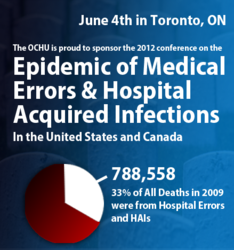Long-term care and pedicures
Of all the weaknesses in American health care, long-term care facilities display the worst. Regular hospitals have their problems; that medical word ‘complications’, as in the familiar phrase ‘died of complications after surgery’, indicates the long-running problem our hospitals still have with keeping clean. Indeed, even a hospital with state-of-the art resources for organ transplant, for example, can show a baffling inability to keep infectious bacteria away from patients. Simple as the notion of cleanliness may be, it often remains beyond the reach of hospital management, and the anti-regulation, anti-inspection, anti-redress mantra of one of our major political parties often puts the problem beyond the reach of the public. But the problems in other health-care facilities pale in comparison to those of long-term care facilities.

Germs and other errors
In part, this is the human factor. Employees in long-term care, after all, often deal with the patients for whom there is the least hope. Long-term care for a patient with advanced dementia, or multiple sclerosis, or some kinds of cancer, means a door that opens only one way. Long-term care for the mentally ill can be even more disheartening. Even without the extra abuse of foisting off small-time drug dealers and other crooks on the facilities–who then prey upon the mentally ill residents, and manage to take from them any small possessions they still have–there is the difficulty of dealing with someone too cognitively impaired to communicate, and above all there is the difficulty of dealing with someone who shows so little potential for future development. Every parent knows the stresses of taking care of a toddler–but a two-year-old toddles at the doorsill of a universe of potential. The strain of constant watching over a young child is more than compensated, not only by love and affection, and by the entertainment factor–So that’s where your keys went/why the dishwasher went on the fritz–but by the constant awareness that the toddler has the possibility of a rich and full life ahead. In taking care of someone with advanced Alzheimer’s, or schizophrenia, or any psychotic condition, think toddler-care squared. Dementia patients, like toddlers, cannot be safely left alone, even for minutes at a time; the severely mentally ill, like toddlers, cannot communicate clearly with medical personnel. The difference from toddlers is that the emotional payback is infinitely less. It takes a healthy, strong, cheerful individual to staff a facility for the care of lifelong underdogs.
Unfortunately, beyond the human factor is the corporate factor. Employees in long-term care tend to be among the lowest paid and the least trained in the realm of health care. Their supervision is much less likely to take into account the quality of patient care than the possibility of union organizing. Indeed, every piece of writing on management of long-term care facilities has as its unwritten rubric ‘This Is How You Avoid Having Your Employees Organize’. That title might as well be printed on every page of every management binder, at least in invisible ink perceivable only to the ever-increasing tiers of sales personnel, business office personnel, and other administrators/handlers of the corporate products that also increasingly influence law firms and universities at every level now.

Best practices pyramid
The result is that you’re lucky to get any care of the patient, or resident. No matter how much you pay, no matter how good the sales pitch, no matter how many pages of forms you fill out as to patient food preferences, daily needs and even medical history, you can count yourself lucky if the person being treated gets day-to-day care at the most basic level. This melancholy conclusion is not only mine, but also that of every person I know and have talked with, about long-term care for older patients and other cases. Setting aside any worse abuses, one old friend told me about a health aide who induced his elderly mother to write a personal check for $85,000–fortunately caught and stopped by her bank. The jewelry of one friend’s mother was stolen from her drawers, by people there to take care of her. A more fundamental problem is that the wrongful acts of commission are far outnumbered by more passive omissions, when health problems become worse when compounded by neglect. One old friend of mine estimates, from observation and experience, that maybe twenty percent of long-term care employees actually take care of the patients.

Actual volunteer, not photographer's model
There is no one-stop, one-shop solution to this problem. Most facilities know already that a good video-monitoring set-up can help. Many states and localities already enjoy the benefit of young volunteers, who come in as part of a school program and estimably boost the cheerfulness and energy of any place they help out in.

Cleaning?
There are, however, some simple steps that as part of a multi-valent approach can up the quality of long-term health care, and can reduce the incidence of health-threatening and life-threatening conditions. Regrettably, these are so simple and down-home that, like hospital cleanliness, they lack the cachet of organ transplant. Therefore they fail to generate support, because they do not attract the resources of high-profile medical procedures. No corporate structure stands to make money off them.
Saving space and time for now, let’s start with two–dental care and foot care.
Dentists and podiatrists know the importance of healthy teeth and feet. The rest of us have a way to go, seemingly, to catch up. Fortunately for the American public, at a time when health care costs are going up–and of course, as always, the price of health insurance is going up–many tennis shoes, sandals and boots are more healthful, less destructive to the bones of the foot, than earlier shoe models. Plenty of killer shoes are still out there–media attention to anexoria and bulimia has not yet taken in the ankle-breaking shoe substitutes, thin-soled and unsupportive, also marketed to young people. And unfortunately good sneakers are often manufactured abroad rather than in the U.S. But young people today at least have the possibility of growing up with fewer foot problems than did their elders.
Patients and residents in long-term care need foot attention so routinely it’s a shame the issue can’t be built into those training binders for managers. (But see union- and organizing-prevention, above.) Foot issues are a known consequence of diabetes; however, all patients–especially those who cannot speak for themselves, or speak lucidly–need the attention. At the substantial risk of seeming to trivialize this issue, a few stopgap measures could help at the place-to-place level.
One is a visit to the nail salon. Schedule a visit to get a pedicure for the patient, and watch what unveils when the sock comes off. Blisters, bunions, infection, hammertoes, ingrown nails–the pedicurist sees them all, and anything the pedicurist can see, medical personnel should be able to see. The idea here, of course, is follow-up, not just observation for its own sake. It is always risky to use personal anecdote to illustrate a point, but I find it incredible that my brother, in a long-term facility, was hospitalized recently–and two hospitals failed to notice that he had a foot infection. Don’t they disrobe patients in hospitals, take down details in medical charts, and pass the notes along to the physician in charge? Don’t they alert senior medical personnel to any potentially life-threatening condition or wound?
This was in Houston, if that’s relevant.
Back to the pedicure trip–it might sound silly, but it could help. The outing itself would be relatively pleasant for the patients, the feel and look of the manicure and pedicure comforting. Caretakers could be included; they have their own issues, after all. Most importantly, with even a little bit of organized record-keeping, any problems could be noted, and then done something about. Problems the pedicurist could not cure could be treated by physicians soon after. Improving foot health not only reduces the danger of infection to the rest of the body, it also improves the possibility of exercise and mobility.
Dental issues are foot issues on steroids. More than ample clinical evidence has long demonstrated that deep problems with teeth and gums endanger the entire body, including the heart. Veterinarians know it, as well as human doctors–examining the teeth and gums is routine, because protecting tooth and gum health is essential to, for example, the kidneys. So–condensing the message, here–frequent visits to the dentist should be routine for the residents or patients in long-term care facilities, by law, and daily dental care should be part of the daily regimen of assistance as a matter of course.
So why aren’t they?
Once again, see the human factor and the corporate factor above. Brushing twice a day, multiplied by the number of patients, takes time and labor. Management doesn’t want to pay for the labor, or hire the staff sufficient to handle it, or train employees. And while frequent headlines about frail elderly people found sitting or lying in their own feces have shamed most long-term care facilities into providing incontinence care, there have been no headlines about abscesses in the gums.
Final note: Yes, I know this is a buzz-kill. But the daunting size of the target–improving long-term care–has its upside: It’s so big that it would be hard to miss.
more later








